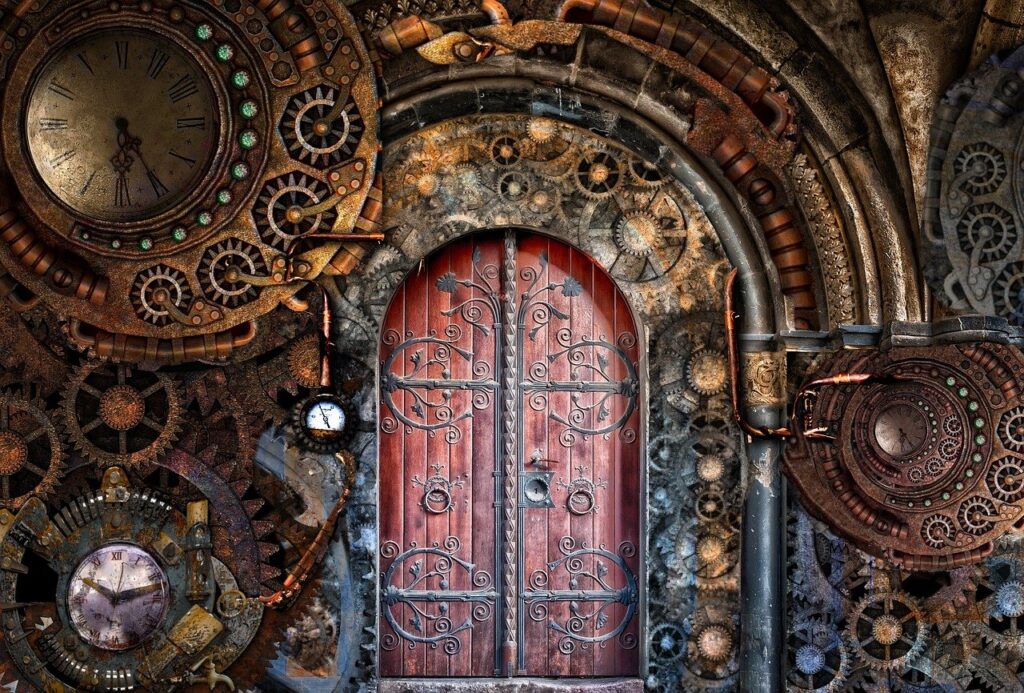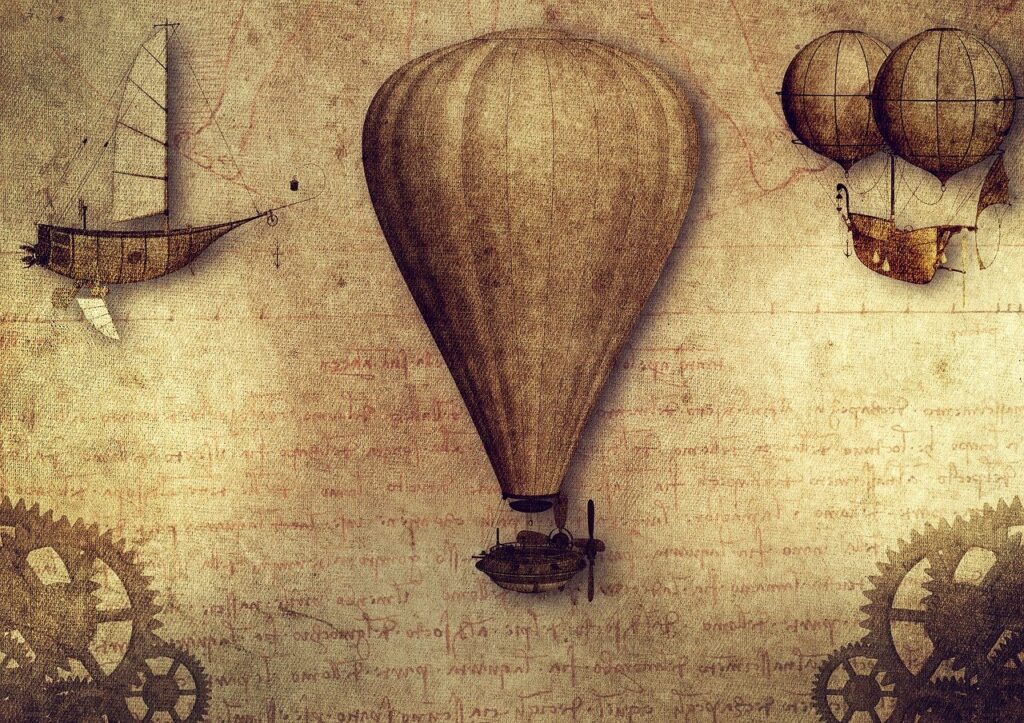Imagine stepping into a world where intricate machinery and Victorian elegance merge effortlessly. This captivating article takes you on a journey through the fascinating history of steam punk time pieces. From its humble beginnings to its undeniable influence on fashion and design, you’ll discover the evolution of these unique and whimsical creations. Join us as we explore the past, present, and future of steam punk time pieces, where imagination and innovation collide to bring us a truly remarkable blend of art and technology. Get ready to be swept away as we unveil the secrets behind these extraordinary timekeeping devices.

Invention of Steam Power
Steam power, one of the most influential developments in human history, had its earliest origins in the ancient world. From the time of Hero of Alexandria’s steam-powered devices in the 1st century AD to the early experimental steam engines of the 17th century, humans have been fascinated by harnessing the power of steam for mechanical purposes. However, it was during the Industrial Revolution in the 18th century that James Watt made significant improvements to the steam engine, revolutionizing its efficiency and reliability.
Early development of steam engines
The early development of steam engines can be traced back to the 17th century when inventors like Thomas Savery and Thomas Newcomen created crude machines that used steam to pump water out of mines. Although these early engines were far from efficient, they laid the foundation for further advancements in steam power.
James Watt’s improvements
James Watt, a Scottish engineer, is widely regarded as the father of the modern steam engine. In the late 18th century, Watt made significant improvements to the design, introducing a separate condenser and a rotary motion mechanism. These innovations greatly increased the engine’s efficiency, making it a practical power source for industrial machinery.
First steam-powered machinery
With the improvements made by James Watt, steam power rapidly expanded its applications in various industries. The first steam-powered machinery emerged in the late 18th century, including textile mills, ironworks, and breweries. Steam power revolutionized these industries, increasing production capacity and driving economic growth during the Industrial Revolution.
Victorian Era Influence
The Victorian era, spanning from 1837 to 1901, had a profound impact on the development of steam power and its subsequent influence on society and culture.
Industrial revolution and steam power
The Industrial Revolution, which occurred during the Victorian era, saw an unprecedented expansion of steam power. Steam engines were utilized across various industries, powering factories, locomotives, and ships. This era marked a fundamental shift in the way society functioned, with steam power becoming a driving force behind economic growth and technological advancement.
Romantic and Gothic literature
The Victorian era was also characterized by a fascination with Romantic and Gothic literature, which often featured steam-powered machinery as central elements. The works of authors like Mary Shelley and Jules Verne captured the imaginations of readers with their depictions of steam-powered inventions, creating a sense of wonder and curiosity surrounding this emerging technology.
Fashion and aesthetics
The Victorian era was known for its elaborate fashion and aesthetics, heavily influenced by the advancements in technology. The Industrial Revolution gave rise to intricate machinery and mechanical elements, which found their way into fashion and design. Gears, cogs, and brass became popular motifs, reflecting a society enamored with the beauty of industrial machinery.
Emergence of Steampunk Genre
The emergence of the steampunk genre in the latter half of the 20th century can be attributed to a combination of literary influences, cultural shifts, and a desire for alternative history.
Steampunk literature and subculture
Steampunk literature, which combines elements of science fiction, fantasy, and the aesthetics of the Victorian era, emerged as a distinct genre in the 1980s. Authors like Jules Verne and H.G. Wells, whose works laid the foundation for Victorian scientific romances, inspired the steampunk movement. This literary movement gave rise to a subculture of enthusiasts who embraced the retro-futuristic aesthetics and ideals of the genre.
Jules Verne and H.G. Wells
Jules Verne and H.G. Wells, two prominent authors of the 19th century, played a crucial role in shaping the steampunk genre. Verne’s works, such as “20,000 Leagues Under the Sea” and “Journey to the Center of the Earth,” showcased imaginative steam-powered inventions, while Wells’ “The Time Machine” explored the concept of time travel within a Victorian setting. These visionary authors set the stage for the steampunk movement.
Influence of cyberpunk and alternative history
The rise of cyberpunk literature in the 1980s, with its dystopian themes and futuristic technology, also heavily influenced the steampunk genre. The blending of cyberpunk’s futuristic elements and the Victorian era’s aesthetics gave birth to a unique subgenre that explored alternative histories and fantastical worlds. Steampunk became a means of revisiting the past through a lens of speculative fiction.
The Origins of Steampunk Timepieces
Steampunk timepieces, often referred to as “clockwork wonders,” draw inspiration from Victorian pocket watches and industrial charms, merging the old-world charm with modern technology.
Inspiration from Victorian pocket watches
Victorian pocket watches, with their intricate designs and mechanical movements, serve as the primary inspiration for steampunk timepieces. Craftsmen and artists began repurposing these vintage timepieces, incorporating their mechanisms into new and visually stunning designs. The elegant aesthetics and precision engineering of pocket watches found new life in the steampunk genre.
Industrial charms and motifs
The industrial revolution’s influence on steampunk timepieces is evident in the use of industrial charms and motifs, such as gears, cogs, and brass accents. These mechanical elements not only add a unique visual appeal but also serve as a nod to the age of steam power. By incorporating these industrial elements, steampunk timepieces carry the essence of the Victorian era in their design.
Integration of modern technology
Despite being inspired by the past, steampunk timepieces often feature integration with modern technology. This fusion of old and new creates a sense of juxtaposition, pairing antique aesthetics with contemporary functionality. From incorporating LED displays to GPS capabilities, steampunk timepieces embrace the advancements of the present while remaining rooted in the aesthetics of the past.

Design and Mechanics of Steampunk Timepieces
The design and mechanics of steampunk timepieces combine intricate aesthetics, the use of gears and cogs, and the incorporation of mechanical movements, creating truly unique works of art.
Ornate and intricate aesthetics
Steampunk timepieces are known for their ornate and intricate aesthetics, featuring elaborate engravings, filigree work, and detailed metalwork. Craftsmen put great attention to detail, creating timepieces that capture the essence of the Victorian era. The complex designs often depict fantastical elements, such as airships, steam-powered locomotives, and mythical creatures, further emphasizing the genre’s imaginative nature.
Use of gears, cogs, and brass
Gears and cogs play a central role in the design of steampunk timepieces, both as functional elements and decorative accents. The visible arrangement of gears and cogs adds a sense of dynamic movement to the timepieces, even if they are purely aesthetic. Brass, with its warm golden hue, is a commonly used material, reflecting the industrial origins of steam power and adding a touch of vintage charm.
Incorporation of mechanical movements
Steampunk timepieces often incorporate mechanical movements, enhancing their vintage appeal. These movements, powered by springs and gears, provide the timekeeping functionality without relying on modern electronic components. The use of mechanical movements not only highlights the craftsmanship and precision engineering but also adds a tactile connection to the inner workings of the timepiece.
Famous Steampunk Timepiece Creators
Several accomplished artists and watchmakers have gained recognition for their contributions to the steampunk timepiece genre.
Katsuhiro Otomo
Katsuhiro Otomo, a Japanese manga artist and director, is known for his influential steampunk-themed manga and anime series called “Akira.” Through his work, Otomo introduced a dystopian futuristic setting set in Neo-Tokyo, featuring an abundance of steam-powered machinery, including vehicles and timepieces. Otomo’s distinct style and imaginative storytelling greatly influenced the steampunk aesthetic.
Daniel Dugan
Daniel Dugan, an American artist, is renowned for his intricate steampunk timepieces. Dugan’s creations often meld elements of vintage pocket watches with modern technology, resulting in visually stunning and functional timepieces. His attention to detail and skillful craftsmanship have made him a prominent figure in the steampunk timepiece community.
Haruo Suekichi
Haruo Suekichi, a Japanese watchmaker, is recognized for his exquisite steampunk-inspired wristwatches. Suekichi’s timepieces combine traditional watchmaking techniques with steampunk aesthetics, featuring intricate engravings, mechanical movements, and unique designs. His dedication to preserving the art of watchmaking while infusing it with steampunk elements has earned him accolades within the industry.

Collecting and Valuing Steampunk Timepieces
Steampunk timepieces have become highly sought after by collectors, with factors such as limited editions, custom pieces, and community influence affecting their value.
Limited edition and custom pieces
Limited edition and custom steampunk timepieces hold great value within the collecting community. These unique pieces, often produced in limited quantities or as one-of-a-kind creations, garner attention for their exclusivity and rarity. The craftsmanship, artistry, and attention to detail present in these pieces make them highly desirable among collectors.
Factors affecting value
Several factors influence the value of steampunk timepieces, including the reputation of the creator, the complexity of the design, the use of high-quality materials, and the historical significance of the piece. Timepieces crafted by renowned artists or featuring intricate engravings and complex mechanisms tend to command higher prices in the market.
Collecting community and markets
The growing popularity of steampunk timepieces has led to the formation of dedicated collecting communities and markets. Enthusiasts gather at steampunk conventions and events, where timepieces are bought, sold, and traded. Online platforms and forums provide avenues for collectors to connect and exchange information, further fueling the interest in steampunk timepieces.
Modern Steampunk Timepieces
Modern steampunk timepieces continue to evolve, embracing the integration of modern technology and expanding their influence to other accessories.
Use of modern technology
While steampunk timepieces draw inspiration from the past, they are not confined to antiquated technology. Modern steampunk timepieces often incorporate modern advancements, such as automatic movements, electronic displays, and even smartwatch capabilities. This fusion of old and new ensures that steampunk timepieces remain relevant and functional in today’s technological landscape.
Integration with other accessories
Steampunk timepieces have expanded beyond stand-alone wristwatches and have integrated with other accessories. Steampunk-inspired jewelry, such as necklaces, earrings, and brooches, often feature miniature timepieces as focal points. These accessories allow individuals to incorporate the steampunk aesthetic into their overall style, creating a cohesive and eye-catching look.
Influence on mainstream fashion
The influence of steampunk timepieces has extended beyond the steampunk subculture and infiltrated mainstream fashion. Elements of steampunk design, such as brass accents, gear motifs, and Victorian-inspired aesthetics, can be seen in clothing, footwear, and even home decor. The distinct steampunk style has become a source of inspiration for fashion designers looking to infuse a sense of adventure and nostalgia into their creations.
Steampunk Timepieces in Popular Culture
Steampunk timepieces have left an indelible mark on popular culture, appearing in various forms of media, including film, television, literature, and gaming.
Film and television references
Steampunk timepieces have made appearances in films like “Sherlock Holmes” and “The League of Extraordinary Gentlemen,” where the characters don elaborate steam-powered gadgets and accessories. Television shows such as “Firefly” and “Doctor Who” have also featured steampunk-inspired timepieces, adding a touch of retro-futurism to their visual aesthetics.
Role-playing games and literature
Steampunk timepieces have found a natural home in role-playing games and literature. Games like “Dishonored” and “BioShock Infinite” transport players to steampunk-inspired worlds filled with intricate timepieces and fantastical machinery. In literature, steampunk timepieces often play a pivotal role in shaping the narrative and create a sense of wonder and adventure in alternative histories and fictional worlds.
Steampunk conventions and events
Steampunk conventions and events have become a hub for enthusiasts to showcase their love for the genre, including their timepiece collections. These gatherings celebrate the unique blending of history, technology, and imagination that the steampunk movement embodies. Attendees showcase their steampunk-inspired outfits, accessories, and timepieces, creating a vibrant and immersive experience for all involved.
Future Outlook for Steampunk Timepieces
Steampunk timepieces are likely to continue their growth and innovation, with potential influences on other industries, such as fashion and design, while also addressing concerns of sustainability and ethical manufacturing.
Continued growth and innovation
As the steampunk genre continues to captivate the imaginations of enthusiasts, the demand for unique, well-crafted timepieces is expected to grow. Advancements in manufacturing techniques and technology are likely to fuel further innovation, allowing for the creation of even more intricate and imaginative designs.
Influence on other industries
The steampunk aesthetic has already made its mark on fashion, design, and entertainment. As its popularity continues to rise, it is anticipated that the influence of steampunk timepieces will extend into other industries as well. From architecture to automotive design, elements of steampunk may find their way into a variety of creative pursuits, bringing a touch of history and fantasy to contemporary culture.
Sustainability and ethical manufacturing
As the world becomes more conscious of sustainability and ethical manufacturing, the future of steampunk timepieces will likely see a greater emphasis on environmentally friendly materials and responsible production practices. Innovations in sustainable materials and fair-trade initiatives may shape the way steampunk timepieces are created, ensuring that they resonate not only aesthetically but also ethically with consumers.
In conclusion, the history of steam punk timepieces encompasses the early development of steam engines, the influence of the Victorian era, the emergence of the steampunk genre, the origins, design, and mechanics of steampunk timepieces, the renowned creators, collecting culture, modern adaptations, and the impact on popular culture. With continued growth, diverse influences, and a focus on sustainable practices, the future of steampunk timepieces promises to be exciting and ever-evolving.

